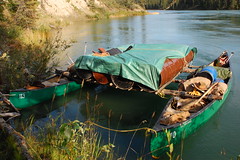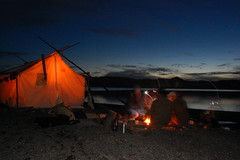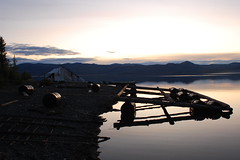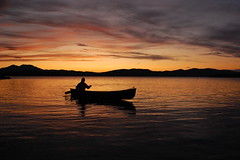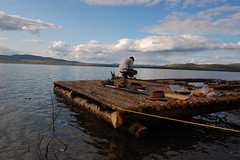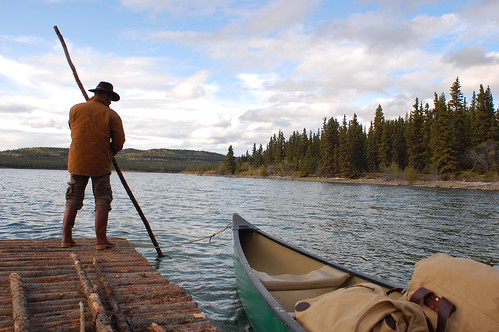Canada : Going down the Yukon river.
the descent of the Yukon starts to take shape... The team increases in number, the beginning of the building of the raft.
- third of 5 articles on this subject, first published in French, translated by Joanna Bremond.
The plan to go down the Yukon for 700 km started to take shape. If in itself it seemed reasonable, in view of the fact that each year hundreds of visitors travel over several sectors of this route in canœs or kayaks, involving limited risks, our present plan was a little more complicated and uncertain. The originator of the expedition sold the idea to his sponsor of a traditional “old-time” descent on a wooden raft. This was to be built in situ, and was to be equipped with a prospector’s tent and a stove, the whole idea being that such a set-up would be photogenic, representing values such as “nature, virility, and adventure”. If this project appeared surprising and somewhat exceptional, I learnt that it wasn’t in fact all that surprising, for each year the inhabitants of Whitehorse see eccentrics passing who somehow manage to go downriver on home-made rafts.
The first thing to be noted is that we are three, for the moment - an uneven number which wasn’t a good omen for the adventure. Obviously we would have to hire two 6.5 metre canœs, which would have first to travel on the raft as far as mid trip, before becoming the only means of transport until the arrival at Dawson city. The team had therefore to get hold of another oarsman, as the canœs would be loaded and therefore impossible for one person to manœuvre… The first candidate to appear was an American in his sixties. In spite of obvious experience as an adventurer, he seemed to be more used to solitary trips, therefore less able to fit in with the discipline of a group - or at least this was the guide’s opinion, the risk being that he could decide to abandon the trip en route, for example at Carmacks, half-way, about 300 km downstream - in fact the only point where it is possible to rejoin civilisation.
We then met two girls on the campsite. They were travelling together, one, a Parisienne at the end of the last month of a year’s Sabbatical trip round the world, and the other one a New Zealander, a hippie type who had worked in England, and wanted to stay on in Canada for a while. They both seemed sporty and resourceful and capable of living rough for a while.
They were tempted by the adventure but wanted to stay together. The only problem was that the French girl had a deadline for a return flight to Paris which she had just reserved… The decision was made, however, and henceforth we would be “The Adventurous Five”. We had a conference, as it was necessary to define the project, the means, the role of each member of the team, buy all the necessary equipment (ropes, nails, shovels, hammers) as well as food for at least two weeks.
“Phase 1” was the building of the raft. The guide, who had consulted several archives, already had some ideas. Official permission for using wood had to be obtained. The girls agreed to be mainly responsible for the cooking, and each member of the team agreed to participate in all the necessary jobs, either the building of the raft or the setting up of camp. The security regulations were set out by the guide, who possessed French and Canadian professional diplomas, inspired confidence, and seemed exacting and very particular about security. Each member of the team agreed to take out insurance for emergency repatriation, to wear a life jacket at all times during navigation, and to check that all equipment was in good condition, and suitable for this sort of adventure, in particular for possible changes of climate.
Our days were very full. In my case, I had to complete my equipment, as what I used for my treks round Jasper in the summer was no longer sufficient. Top priority was to replace my sleeping bag for a thicker one, able to withstand temperatures of minus 7°. We left unnecessary personal belongings in Whitehorse, only, on the guide’s advice, taking the strict minimum. With hindsight, this “minimum” turned out to be insufficient - pharmaceutical stocks, for example, were limited to a minimum, and we turned out to have only just enough Tylenol, lighters, clothes, survival bags, and even toothpaste. We also discovered that it would have been better not to have abandoned certain other items, such as a water-purifier and fire-lighters. The necessary effort and time to prepare the trip having been under-estimated, we also found we needed to buy more provisions half way down.
Certain procedures only took place at the last moment, for example the purchase of a distress beacon, vital for our security. This device, a GPS Spot, was able to send our exact daily geographic position to a list of pre-programmed Internet addresses, and to alert the authorities in case of a major incident or accident. It turned out to be reliable, our families and friends being able to follow our daily progress, and fortunately we didn’t need to find out how fast help would have arrived…
- credits © Romain Dartigue -
Things started to get serious on September 1st. We found ourselves on the edge of the river at Whitehorse, with our two canœs, all our equipment and our 12 used kerosene barrels which discreetly kept our wooden raft afloat. The first problem was how to transport all the above as near as possible to our departure point, where we would build the raft at the other end of Lake Laberge. To reach that point we had to go downstream for 20 km, and then cross the lake. The latter is narrow, and about 30 km long. Using the two canœs as floats, we built a sort of catamaran - then full steam ahead! Carried by the current it took us two days to get to the other end of the lake, which we crossed paddling and struggling!
We set up camp and installed the tent and the stove. Our food reserves were stocked a good distance away from our camp. We had been advised to keep them at least a hundred metres away (though we only rarely went to this extent). Black and grizzly bears are numerous in this territory, and the locals like to say that there are more bears than inhabitants. Nothing that attracts their sense of smell or taste should be kept nearby; otherwise there is the risk of their coming to devastate the camp in the middle of the night, with the possibility of serious danger to ourselves.
The following night we nearly had a catastrophe. We woke up coughing, for the tent, hermetically closed to protect us from the cold, was full of thick smoke from the stove. We all rushed outside in our underclothes. I had a temperature for the following days, but it wasn’t the best moment to have health problems. The building of the raft, which should have taken two or three days, kept us all busy and needed more energy and time than we could have imagined. Unexpected technical problems, choosing the right trees (we were only allowed to use dead ones), chopping, disbranching, dragging them and assembling them… We had to go deeper and deeper into the woods to find suitable ones, and were bitten by clouds of insects, attracted by our sweat and our thinner skins than the local fauna.
We found we hadn’t enough nails, but decided to try to find more from the wood, washed up along the edges of the lake, and we then had to straighten them out - and all that took time. We were off schedule, the Parisian girl started worrying about the delays, and finally all the rest of us started to get impatient too. If things didn’t get better, would we manage our trip in time?
Every day we learnt more about the difficulty of translating theory into reality. From the yellowed photo of one of the rafts used by prospectors, to the actual building of one, there is a world of difference. How would we be able to move this enormous 4 x 7 metres raft down to the end of the lake? How would we be able to manœuvre it, steer it, or stop it? These questions arose as the work continued. We built a leeway device but it turned out to be too heavy, and of no use as we needed to use 6 meters poles to get it moving.
Apart from flies and other blood-sucking insects there wasn’t a soul around to be amazed at our strange goings-on, or even to give us advice ! A young Japanese stopped briefly - he spoke a little English - and we realised it was the first time he’d handled a kayak… He intended to go downstream as soon as he got the knack, and he practiced for a while nearby before heading downstream, and I heard later that he had got through safely.
As for us, we got up at the crack of dawn each day, still exhausted, surrounded by water birds - barnacle geese and loon - and each evening we were exhausted, with hands bruised and bleeding, but we continued to work until sunset, about 11 pm.
Six days, and more than 120 trees later, we loaded the raft, and at last we were ready to take off down what is called, respectfully, the “Grande Rivière”. We were looking forward to leaving the area and changing horizons. We left around 17 h, feeling more confident as the days grew longer… it was a bit late for what still remained undone, but we were to discover this without delay, and at our own expense…
- Previous article here.
- from a story told by Romain Dartigues - translated by Joanna Bremond -
